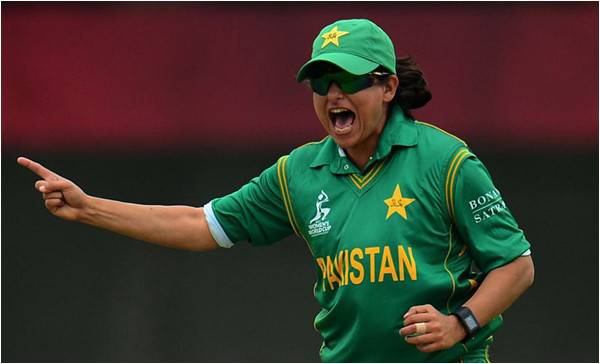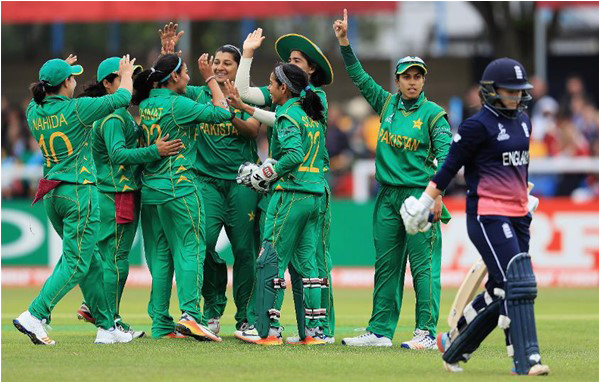
This piece is being written before Pakistan take on the favourites and the defending champions Australia. And although the national side has lost its first three matches it hasn’t been without a fight.
Pakistan were denied a great comeback win in their opening contest when South Africa held on at the very end. After Pakistan put 206 on the board, South Africa were once 113 without the loss of any wickets after 25 overs. Pakistan rallied back to have the Proteas struggling at 177-7 at the end of the 45th. Had Sune Luus and Shabnim Ismail not put up a late partnership Pakistan would’ve been off to the perfect start in the World Cup, but the team’s fighting spirit garnered universal acclaim.
The South Africa game was followed by a mammoth batting performance by England who piled up 377 runs against a wayward Pakistani bowling on the day. Centuries from Heather Knight and Natalie Sciver laid the foundation for the score, with the rain marred contest going to the hosts England by 107 runs (D/L method).

Sunday’s game against India, like any Indo-Pak cricket clash, was of course billed that much greater. What also contributed to this is the fact that Pakistan have beaten India twice in the World T20 – 2012 and 2016. But in the previous nine ODIs that the two sides have contested Pakistan hadn’t won a match. India made it 10 on Sunday.
But Pakistan did have the better off India in the first half. With six wickets between them, left-arm spinners Nashra Sandhu (four) and Sadia Yousuf(two) restricted India to their lowest ever 50-over total against Pakistan: 169. The fast bowling and fielding of Diana Baig were impressive as well, which lifted the team’s overall fielding as well. But unfortunately, the batting completely capitulated against Indian left-arm spinner Ekta Bisht who took 5/18 in her 10 overs, as Pakistan were all out for 74.
Despite the losses there have already been a lot of positives for the national side and it’s still a learning curve for them in the 50 over format.
Diana Baig is a great athlete and could form a good pace bowling partnership with Asmavia Iqbal. Nashra and Sadia have already proved themselves to be world class spinners. Openers Nahida Khan and Ayesha Zafar both have half centuries each against quality bowling. And in the inspirational Sana Mir, the team has a leader they can follow and look up to.
Like the World T20s in recent years, this ODI World Cup would prove to be a stepping stone for the national women’s team who would look to replicate their 20-over results in the longer version in the very near future.
Pakistan were denied a great comeback win in their opening contest when South Africa held on at the very end. After Pakistan put 206 on the board, South Africa were once 113 without the loss of any wickets after 25 overs. Pakistan rallied back to have the Proteas struggling at 177-7 at the end of the 45th. Had Sune Luus and Shabnim Ismail not put up a late partnership Pakistan would’ve been off to the perfect start in the World Cup, but the team’s fighting spirit garnered universal acclaim.
The South Africa game was followed by a mammoth batting performance by England who piled up 377 runs against a wayward Pakistani bowling on the day. Centuries from Heather Knight and Natalie Sciver laid the foundation for the score, with the rain marred contest going to the hosts England by 107 runs (D/L method).

Sunday’s game against India, like any Indo-Pak cricket clash, was of course billed that much greater. What also contributed to this is the fact that Pakistan have beaten India twice in the World T20 – 2012 and 2016. But in the previous nine ODIs that the two sides have contested Pakistan hadn’t won a match. India made it 10 on Sunday.
But Pakistan did have the better off India in the first half. With six wickets between them, left-arm spinners Nashra Sandhu (four) and Sadia Yousuf(two) restricted India to their lowest ever 50-over total against Pakistan: 169. The fast bowling and fielding of Diana Baig were impressive as well, which lifted the team’s overall fielding as well. But unfortunately, the batting completely capitulated against Indian left-arm spinner Ekta Bisht who took 5/18 in her 10 overs, as Pakistan were all out for 74.
Despite the losses there have already been a lot of positives for the national side and it’s still a learning curve for them in the 50 over format.
Diana Baig is a great athlete and could form a good pace bowling partnership with Asmavia Iqbal. Nashra and Sadia have already proved themselves to be world class spinners. Openers Nahida Khan and Ayesha Zafar both have half centuries each against quality bowling. And in the inspirational Sana Mir, the team has a leader they can follow and look up to.
Like the World T20s in recent years, this ODI World Cup would prove to be a stepping stone for the national women’s team who would look to replicate their 20-over results in the longer version in the very near future.

